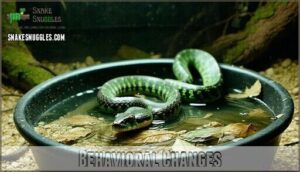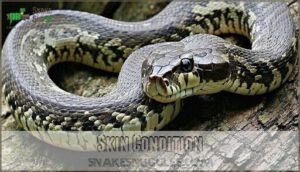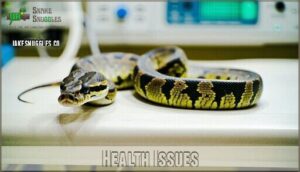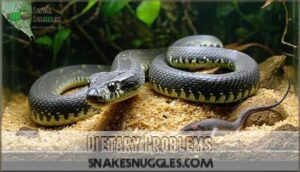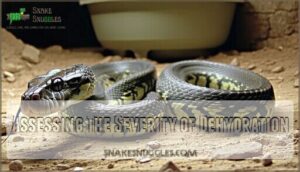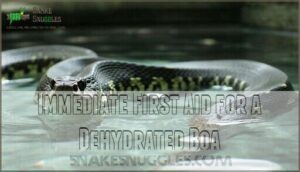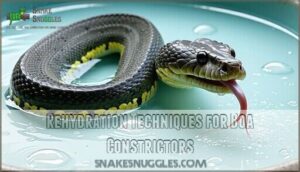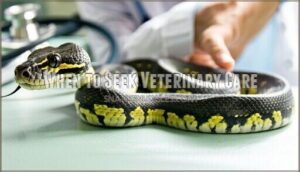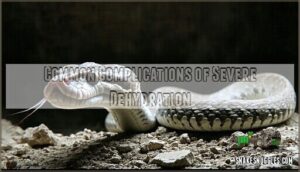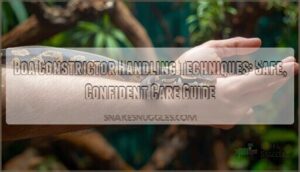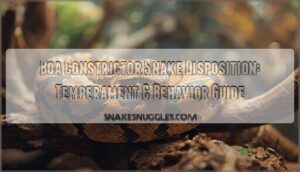This site is supported by our readers. We may earn a commission, at no cost to you, if you purchase through links.
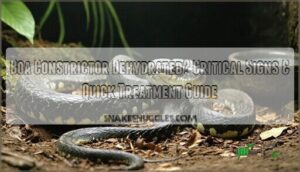
Your snake might become lethargic and refuse food. Low humidity, inadequate water sources, or illness typically cause this condition.
Start treatment immediately by soaking your boa in lukewarm water for 15-20 minutes, then boost enclosure humidity to 60-70%. Monitor their water bowl daily and make certain it’s large enough for soaking.
Severe cases need veterinary attention fast. Understanding the root causes and proper prevention methods can save your snake‘s life, and it’s crucial to act with immediate treatment.
Table Of Contents
- Key Takeaways
- Signs of Dehydration in Boa Constrictors
- Causes of Dehydration in Boas
- Assessing The Severity of Dehydration
- Immediate First Aid for a Dehydrated Boa
- Rehydration Techniques for Boa Constrictors
- When to Seek Veterinary Care
- Long-term Care and Prevention
- Common Complications of Severe Dehydration
- Frequently Asked Questions (FAQs)
- How to rehydrate a boa constrictor?
- How do I know if my boa is dehydrated?
- How do you rehydrate a dehydrated snake?
- How do you tell if a snake is dehydrated?
- How to rehydrate a boa?
- What to do if your snake is dehydrated?
- How to give a snake electrolytes?
- How long can a boa constrictor go without eating?
- How long can a boa constrictor survive without water?
- Can dehydration affect a boas ability to shed?
- Conclusion
Key Takeaways
- Spot the warning signs early – You’ll see wrinkled skin that doesn’t snap back when pinched, sunken eyes with dented caps, lethargy, and difficulty shedding. These symptoms mean your boa is losing critical fluids fast.
- Start emergency treatment immediately – Soak your dehydrated boa in lukewarm water (82-84°F) for 15-20 minutes and boost enclosure humidity to 60-70%. Don’t wait – severe dehydration can cause permanent organ damage within hours.
- Prevent dehydration through proper care – Maintain humidity levels between 50-60%, provide a large water bowl for soaking, and monitor your snake’s environment daily. Poor humidity control and inadequate water access are the main culprits.
- Know when to call the vet – If your boa shows no improvement after 48-72 hours of home treatment, or displays severe symptoms like respiratory distress or complete appetite loss, you need professional intervention immediately.
Signs of Dehydration in Boa Constrictors
You’ll need to watch for specific physical changes in your boa’s appearance, behavior, and skin condition to catch dehydration early.
These warning signs include wrinkled skin that doesn’t snap back when gently pinched, sunken eyes, lethargy, and difficulty shedding properly.
The signs are critical for identifying dehydration and taking appropriate action to ensure the boa’s health and well-being.
Physical Appearance
Several warning signs reveal when your boa constrictor faces dehydration through physical changes.
Watch for these critical indicators:
- Wrinkled skin that lacks skin elasticity – healthy snakes have smooth, supple skin that snaps back when gently pinched
- Sunken eyes with dented or cracked eye caps that appear dull and lifeless
- Triangular body shape showing visible spine definition, indicating severe dehydration alongside weight loss
These symptoms demand immediate attention.
Behavioral Changes
Beyond visible signs, your boa constrictor shows clear behavioral changes when facing dehydration.
Lethargy signs become obvious as your snake moves less and responds slowly to handling.
Appetite changes occur first—your dehydrated snake refuses meals and shows poor feeding response.
Activity reduction and increased hiding behavior signal distress.
Watch for altered drinking habits as even water-loving boas avoid their bowls during boa constrictor dehydration.
Skin Condition
Your boa’s skin condition reveals everything about its hydration status. Healthy snakes have smooth, supple skin that snaps back instantly when gently pinched – that’s the skin elasticity test in action.
Dehydrated boas show wrinkled skin that stays pinched, creating visible folds.
Watch for these warning signs:
- Dented or cracked eye caps indicating severe fluid loss
- Scale appearance becomes dull and lacks natural shine
- Shedding problems with stuck skin patches
Optimal humidity is key to preventing boa constrictor shedding problems. This is crucial for maintaining your boa’s overall health and preventing shedding problems.
Causes of Dehydration in Boas
Understanding what causes dehydration in your boa constrictor helps you prevent this serious health issue before it starts.
Poor enclosure conditions, underlying illness, and inadequate water access are the three main factors that can quickly lead to dangerous fluid loss in these reptiles.
Environmental Factors
Your boa constrictor’s environment directly controls hydration levels.
Poor humidity control and incorrect temperature gradients create deadly conditions.
Enclosure design must include proper water availability and ventilation.
Snake dehydration stems from inadequate habitat maintenance – dry air, wrong temps, or dirty water bowls spell trouble.
| Environmental Factor | Dehydration Risk |
|---|---|
| Low humidity levels | High water loss |
| Poor temperature control | Increased stress |
| Inadequate water access | Direct dehydration |
| Dirty water sources | Avoidance behavior |
| Bad enclosure ventilation | Respiratory issues |
Health Issues
Medical conditions can trigger dehydration in your boa constrictor faster than you’d expect.
These health issues create a domino effect that compromises your snake’s ability to maintain proper hydration levels.
Watch for these critical health problems:
- Respiratory infections – increase water loss through labored breathing
- Parasitic infestations – disrupt normal fluid absorption and retention
- Kidney disease – prevents efficient water processing and storage
- Scale rot and mouth rot – compromise skin barriers and feeding ability
Prompt veterinary care prevents these conditions from escalating into life-threatening dehydration emergencies.
Dietary Problems
A dehydrated snake often struggles with dietary problems that compound hydration issues.
Prey size that’s too large reduces feeding frequency, limiting water intake from food sources.
Nutritional deficiencies develop when your boa constrictor can’t absorb nutrients properly, affecting cellular hydration.
Poor food source quality and inadequate supplementation needs create a cycle where digestive problems worsen dehydration, making recovery more challenging.
Assessing The Severity of Dehydration
Four critical markers help you gauge how serious your boa’s dehydration has become.
Start with the skin elasticity test—gently pinch your snake’s skin and watch how quickly it snaps back.
Healthy skin rebounds instantly, while dehydrated skin stays tented for several seconds.
Check their eye condition next; sunken eyes with dull pupils signal moderate to severe fluid loss.
Examine mucous membranes inside the mouth—they should feel moist, not sticky or dry.
Monitor lethargy levels closely; mildly dehydrated boas move slowly, while severely dehydrated ones barely respond to touch.
Track urination frequency since dehydrated snakes produce less waste.
Look for wrinkled skin along the body—this indicates significant water loss.
These dehydration signs worsen progressively, so catching them early gives your boa the best chance for quick recovery.
Snakes also have a high Salmonella prevalence, which can be exacerbated by stress from dehydration.
Immediate First Aid for a Dehydrated Boa
Acting swiftly when your boa constrictor shows dehydration signs can prevent serious complications. Emergency Hydration begins with creating ideal conditions immediately.
Start by increasing enclosure humidity to 70-80% using a reliable hygrometer. This prevents further moisture loss while you work on active rehydration. Dry, wrinkled skin can be a key indicator of dehydration.
Here’s your emergency action plan:
- Prepare a Lukewarm Soaking bath (82-84°F) with shallow water covering just the bottom third of your snake’s body
- Add reptile-safe Electrolyte Usage solution (1 part electrolyte to 2 parts water) to boost hydration effectiveness
- Monitor your boa during the 15-20 minute soak, ensuring its head stays above water at all times
For severely dehydrated snakes that won’t drink, gentle Syringe Feeding of electrolyte solution may help. Create a Humidity Box with damp moss for ongoing moisture support. Remember, these first aid measures buy you time, but veterinary care remains essential for proper snake hydration recovery.
Rehydration Techniques for Boa Constrictors
When your boa shows signs of dehydration, you’ll need to act quickly with proven rehydration methods that restore moisture safely and effectively.
The three main techniques include controlled soaking baths, strategic misting to boost humidity levels, and electrolyte solutions that help your snake recover faster than plain water alone.
Soaking Methods
Electrolyte baths work wonders for your dehydrated boa constrictor. Set up your tub setup with lukewarm water at 85-90°F, mixing one part Pedialyte with two parts water.
Keep your snake’s head above water during the 20-30 minute soaking duration. For stress reduction, use a secure lid and maintain consistent water temperature.
Remember to provide gentle handling techniques after soaking to minimize stress. Repeat these soaking methods 1-2 times daily until you see improvement.
These rehydration techniques provide immediate relief while supporting your snake’s recovery process.
Misting and Humidity Control
Proper humidity control transforms your boa constrictor’s recovery from dehydration. Misting frequency matters – spray your enclosure 2-3 times daily, targeting hide areas and substrate.
Hygrometer monitoring keeps humidity between 50-60% for ideal healing. It’s important to use accurate humidity monitors for proper enclosure management.
Follow these automated systems for consistent results:
- Install quality misting equipment with timers
- Check humidity gradients across warm and cool zones
- Select appropriate enclosure materials that retain moisture
- Adjust species variations based on your boa’s specific needs to ensure proper enclosure management and ideal healing conditions.
Electrolyte Solutions
Beyond misting, DIY electrolytes can turbocharge your boa’s recovery. Solution concentration matters—mix 75% electrolyte supplement with 25% water for ideal results.
One of the key indicators of dehydration is when the snake’s eye caps become dented.
Here’s your rehydration action plan:
- Warm Bath Method: Heat electrolyte solution to 82-84°F, let your boa soak for 30-60 minutes
- Oral Administration: Offer diluted Pedialyte in shallow dishes for voluntary drinking
- Veterinary Alternatives: Consider subcutaneous fluids for severe cases requiring professional intervention
These administration methods provide essential minerals while supporting your snake’s natural recovery process.
When to Seek Veterinary Care
Your boa constrictor’s recovery depends on recognizing when home treatment isn’t enough. If worsening symptoms persist after 48-72 hours of rehydration efforts, contact a reptile vet immediately.
Emergency signs demanding urgent care include complete loss of appetite, respiratory distress, severe lethargy, or visible muscle deterioration. Don’t wait for no improvement scenarios to escalate.
Complicated cases involving constipation, neurological symptoms, or rapid physical decline require professional intervention. A qualified snake vet can perform blood tests, assess electrolyte imbalances, and identify underlying causes you can’t detect at home.
Preventative checkups help catch dehydration early. Many herp vets offer online consultations for initial guidance. Look for veterinarians with reptile certification through organizations like ARAV (Association of Reptilian and Amphibian Veterinarians).
Your boa constrictor deserves expert care when snake symptoms exceed your home treatment capabilities. Early professional intervention prevents serious complications and saves lives.
Long-term Care and Prevention
Once you’ve successfully treated your boa’s dehydration, you’ll need to focus on preventing future episodes through proper habitat management and consistent care routines.
Establishing the right enclosure conditions, maintaining proper feeding schedules, and monitoring your snake’s health regularly will keep dehydration from becoming a recurring problem, ensuring consistent care is provided to prevent future episodes.
Proper Enclosure Setup
Once you’ve addressed immediate health concerns, setting up your boa constrictor’s home correctly prevents future dehydration episodes.
Your snake enclosure becomes the foundation for long-term health success.
Focus on these three critical elements for proper enclosure setup:
- Temperature Gradient: Create a warm basking spot (88-92°F) with cooler areas (78-80°F) so your boa can thermoregulate naturally.
- Humidity Control: Maintain humidity levels between 50-60% using a reliable hygrometer to monitor conditions consistently.
- Water Access: Provide a large, sturdy water bowl that allows soaking while staying clean and accessible.
Choose appropriate substrate and make certain adequate enclosure size for your boa’s comfort.
Many resources are available for boa enclosure products.
Dietary Considerations
Your boa constrictor’s diet directly impacts its hydration status and overall health.
Hydration Sources come primarily from prey, so consider Prey Moisture content when selecting food items.
Frozen-thawed rodents retain less moisture than fresh prey, making Supplementation Needs vital for preventing dehydration.
Maintain consistent Feeding Frequency and provide Dietary Variety to prevent nutritional deficiencies.
Monitor your snake’s water intake and provide moist food options when needed to support ideal hydration levels.
Regular Health Monitoring
Consistent health monitoring keeps your boa constrictor ahead of dehydration problems.
Weight tracking reveals subtle changes before they become serious.
Shedding frequency and hydration checks tell you if humidity levels are working.
Behavior logging catches early warning signs like lethargy or appetite loss.
Fecal analysis during vet visits detects parasites that worsen dehydration.
Regular health monitoring transforms you from reactive owner to proactive guardian of your snake’s wellbeing.
Common Complications of Severe Dehydration
When prevention falls short, severe dehydration triggers devastating consequences that can permanently harm your boa constrictor. Understanding these complications helps you recognize when immediate veterinary intervention becomes non-negotiable.
Severe dehydration in boas isn’t just uncomfortable—it’s a medical emergency that can cause permanent organ damage within hours.
Organ Failure tops the list of critical concerns. Your snake’s kidneys shut down first, unable to filter toxins from blood. This renal failure creates a domino effect, triggering widespread organ damage throughout the body.
Vision Loss occurs when dehydration affects eye tissues. Dented eye caps and sunken eyes aren’t just cosmetic issues—they signal serious internal problems that can result in permanent blindness.
Here are four major complications requiring immediate attention:
- Kidney Disease – Progressive nephrotoxic damage from chronic fluid deficiency
- Fecalith Formation – Hardened fecal matter requiring surgical removal
- Metabolic Decline – Disrupted cellular processes affecting essential functions
- Respiratory Distress – Compromised breathing patterns from systemic stress
Sepsis represents the final stage, where weakened immunity allows life-threatening infections to spread rapidly through your boa’s system. Difficulty shedding may also arise, indicating severe snake dehydration.
Frequently Asked Questions (FAQs)
How to rehydrate a boa constrictor?
Create a warm electrolyte bath using 75% unflavored Pedialyte and 25% water at 82-84°F. Let your snake soak for 30-60 minutes, then gently wipe away residue with a damp cloth.
How do I know if my boa is dehydrated?
Look for wrinkled, saggy skin that doesn’t snap back when pinched.
Check for dull, sunken eyes with cracked caps.
Notice if your boa’s having trouble shedding or seems unusually lethargic and lifeless.
How do you rehydrate a dehydrated snake?
Like a lifeline thrown to someone drowning, immediate action saves your snake’s life.
Create a warm electrolyte bath using 75% Pedialyte and 25% water at 82-84°F.
Soak for 30-60 minutes, then repeat as needed, this can be considered an immediate action.
How do you tell if a snake is dehydrated?
Check your snake’s skin elasticity by gently pinching it – dehydrated skin won’t snap back quickly.
Watch for wrinkled, saggy skin, sunken eyes, trouble shedding, and lethargy indicating your snake needs immediate rehydration.
How to rehydrate a boa?
Prepare an electrolyte bath using 75% unflavored Pedialyte and 25% water at 82-84°F. Let your boa soak for 30-60 minutes in a covered plastic tub with heating pad underneath.
What to do if your snake is dehydrated?
Give your dehydrated snake a warm electrolyte bath using 75% Pedialyte and 25% water at 82-84°F for 30-60 minutes. Increase enclosure humidity and provide fresh water immediately.
How to give a snake electrolytes?
Mix unflavored Pedialyte with water in a 1:1 ratio, then offer it in a shallow dish. For severe cases, create an electrolyte bath using 75% electrolyte solution and 25% water for soaking treatments.
How long can a boa constrictor go without eating?
Your boa constrictor can survive without food for several months, typically 2-6 months depending on age, health, and body condition.
Adult boas handle fasting better than juveniles who need more frequent feeding.
How long can a boa constrictor survive without water?
Like a desert traveler rationing precious resources, your boa can survive roughly 10-14 days without water.
However, dehydration symptoms appear within 3-5 days, making consistent hydration essential for your snake’s health and survival.
Can dehydration affect a boas ability to shed?
Yes, dehydration substantially impacts your boa’s shedding ability.
When water levels drop, skin loses elasticity and becomes stuck, especially around eye caps.
This creates incomplete sheds that can lead to serious health complications requiring immediate attention.
Conclusion
Like a guardian watching over precious treasure, you’re now equipped to protect your boa from dehydration’s dangers.
Recognizing early warning signs means you can act swiftly when your boa constrictor dehydrated symptoms appear.
Remember that proper humidity levels, adequate water sources, and regular monitoring form your defense strategy.
Don’t hesitate to contact your veterinarian if symptoms persist or worsen.
With consistent care and attention, you’ll keep your serpent companion healthy and thriving for years ahead.
- https://www.sciencedirect.com/topics/agricultural-and-biological-sciences/snake-scales
- https://veterinarypartner.vin.com/doc/?id=8148630&pid=19239
- https://www.vetexotic.theclinics.com/article/S1094-9194(02)00020-8/fulltext
- https://exoticpetvetblog.wordpress.com/2015/12/30/respiratory-conditions-in-reptiles/
- https://www.reptifiles.com/find-your-dream-reptile-vet/


